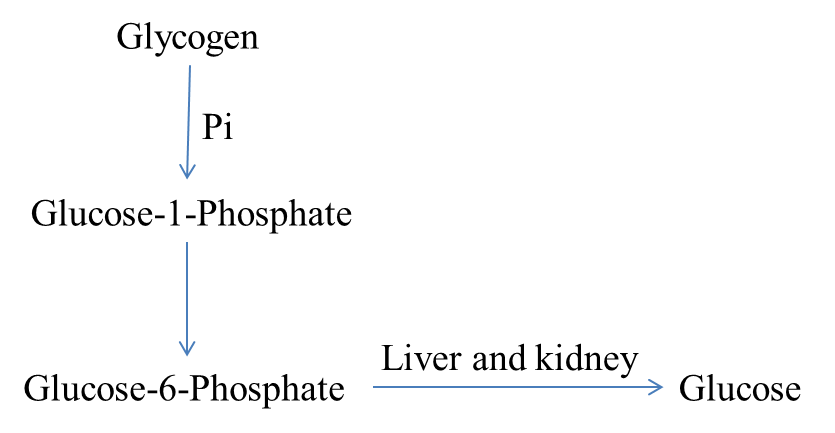
What is the end product of glycogenolysis?
Answer
481.5k+ views
Hint: The polymeric form of glucose molecules is known as glycogen. Insulin will convert the glucose that is present in excess in the blood into glycogen. Glycogenolysis is a process that occurs in the liver to produce glucose.
Glycogenolysis is the process of turning glycogen to glucose. The process of creating glycogen from glucose is known as gluconeogenesis. The term lysis refers to the process of fragmentation. Glycogenolysis is the process of breaking down glycogen into glucose.
Complete answer:
The term "glycogenolysis" refers to the process of breaking down a glycogen polymer into individual glucose units. Glycogen is primarily stored in the muscles and liver.
Glycogen is converted into glucose-$1$-phosphate and then glucose-$6$-phosphate during glycogenolysis.
Glycogen is a polymer made up of glucose as the primary monomer.
Glucose molecules are first hydrolyzed from the chain in glycogenolysis, releasing glucose-$1$-phosphate as a result. The phosphate group is later transferred to the C-$6$ position and glucose $6$-phosphate is formed.
The liver and kidney will then convert glucose $6$-phosphate into glucose.

Hence, glucose is the end product of glycogenolysis.
Additional information:
This procedure is used to release glycogen from the liver and muscles into the bloodstream in the form of usable glucose units. The glycogenolysis pathway is followed as a result of neuronal signalling or hormone production. It usually occurs when the body is stressed due to a low blood sugar level or an emergency situation. When a person is confronted with a potentially dangerous circumstance, the body produces adrenaline or epinephrine. The fight or flight response is the term for this.
Note:
Glycogen is stored in the liver, accounting for around \[5\% \] of its weight. Glycogen is accumulated in the muscles at a rate of \[1 - 2\] percent of their total weight.
In most cases, glycogenolysis takes place in the liver. The liver does not immediately utilise the glucose produced by glycogen. Glucose, on the other hand, enters the bloodstream and is utilised by other cells in the body.
Glycogenolysis is the process of turning glycogen to glucose. The process of creating glycogen from glucose is known as gluconeogenesis. The term lysis refers to the process of fragmentation. Glycogenolysis is the process of breaking down glycogen into glucose.
Complete answer:
The term "glycogenolysis" refers to the process of breaking down a glycogen polymer into individual glucose units. Glycogen is primarily stored in the muscles and liver.
Glycogen is converted into glucose-$1$-phosphate and then glucose-$6$-phosphate during glycogenolysis.
Glycogen is a polymer made up of glucose as the primary monomer.
Glucose molecules are first hydrolyzed from the chain in glycogenolysis, releasing glucose-$1$-phosphate as a result. The phosphate group is later transferred to the C-$6$ position and glucose $6$-phosphate is formed.
The liver and kidney will then convert glucose $6$-phosphate into glucose.

Hence, glucose is the end product of glycogenolysis.
Additional information:
This procedure is used to release glycogen from the liver and muscles into the bloodstream in the form of usable glucose units. The glycogenolysis pathway is followed as a result of neuronal signalling or hormone production. It usually occurs when the body is stressed due to a low blood sugar level or an emergency situation. When a person is confronted with a potentially dangerous circumstance, the body produces adrenaline or epinephrine. The fight or flight response is the term for this.
Note:
Glycogen is stored in the liver, accounting for around \[5\% \] of its weight. Glycogen is accumulated in the muscles at a rate of \[1 - 2\] percent of their total weight.
In most cases, glycogenolysis takes place in the liver. The liver does not immediately utilise the glucose produced by glycogen. Glucose, on the other hand, enters the bloodstream and is utilised by other cells in the body.
Recently Updated Pages
The number of solutions in x in 02pi for which sqrt class 12 maths CBSE

Write any two methods of preparation of phenol Give class 12 chemistry CBSE

Differentiate between action potential and resting class 12 biology CBSE

Two plane mirrors arranged at right angles to each class 12 physics CBSE

Which of the following molecules is are chiral A I class 12 chemistry CBSE

Name different types of neurons and give one function class 12 biology CBSE

Trending doubts
One Metric ton is equal to kg A 10000 B 1000 C 100 class 11 physics CBSE

What is 1s 2s 2p 3s 3p class 11 chemistry CBSE

Discuss the various forms of bacteria class 11 biology CBSE

State the laws of reflection of light

Explain zero factorial class 11 maths CBSE

An example of chemosynthetic bacteria is A E coli B class 11 biology CBSE




